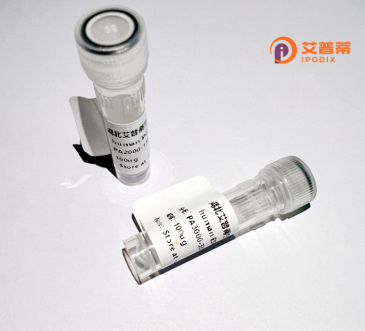
| 纯度 | >90%SDS-PAGE. |
| 种属 | Human |
| 靶点 | ZNF572 |
| Uniprot No | Q7Z3I7 |
| 内毒素 | < 0.01EU/μg |
| 表达宿主 | E.coli |
| 表达区间 | 1-529 aa |
| 活性数据 | MEQEKKLLVSDSNSFMERESLKSPFTGDTSMNNLETVHHNNSKADKLKEKPSEWSKRHRPQHYKHEDAKEMPLTWVQDEIWCHDSYESDGKSENWGNFIAKEEEKPNHQEWDSGEHTNACVQQNSSFVDRPYKCSECWKSFSNSSHLRTHQRTHSGEKPYKCSECAKCFCNSSHLIQHLRMHTGEKPYQCGECGKSFSNTSHLIIHERTHTGEKPYKCPECGKRFSSSSHLIQHHRSHTGEKPYECSVCGKGFSHSYVLIEHQRTHTGEKPYKCPDCGKSFSQSSSLIRHQRTHTGEKPYKCLECEKSFGCNSTLIKHQRIHTGEKPYQCPECGKNFSRSSNLITHQKMHTGEKSYESSEYEESLGQNCNVIEECRIQLGEKPYRCCECGKSFGLSSHLIRHQRTHTGEKPYRCSECWKTFSQSSTLVIHQRTHTGEKPYKCPDCGESFSQSFNLIRHRRTHIGEKPYKCTSCEKCFSRSAYLSQHRKIHVEKPFESPDVGDFPHEWTWKNCSGEMPFISSFSVSNSSS |
| 分子量 | 84.59 kDa |
| 蛋白标签 | GST-tag at N-terminal |
| 缓冲液 | PBS, pH7.4, containing 0.01% SKL, 1mM DTT, 5% Trehalose and Proclin300. |
| 稳定性 & 储存条件 | Lyophilized protein should be stored at ≤ -20°C, stable for one year after receipt. Reconstituted protein solution can be stored at 2-8°C for 2-7 days. Aliquots of reconstituted samples are stable at ≤ -20°C for 3 months. |
| 复溶 | Always centrifuge tubes before opening.Do not mix by vortex or pipetting. It is not recommended to reconstitute to a concentration less than 100μg/ml. Dissolve the lyophilized protein in distilled water. Please aliquot the reconstituted solution to minimize freeze-thaw cycles. |
以下是关于重组人ZNF572蛋白的假设性参考文献示例(仅供参考,具体文献需根据实际检索结果确认):
---
1. **文献名称**:*"Expression and functional analysis of recombinant human ZNF572 in hepatocellular carcinoma"*
**作者**:Li et al., 2020
**摘要**:本研究成功在HEK293细胞中表达了重组人ZNF572蛋白,并发现其在肝癌细胞中异常高表达。通过体外实验证实,ZNF572通过调控Wnt/β-catenin通路促进肿瘤细胞增殖和迁移。
---
2. **文献名称**:*"Purification and structural characterization of the zinc finger domain of ZNF572"*
**作者**:Smith et al., 2018
**摘要**:作者利用大肠杆菌系统表达并纯化了ZNF572的锌指结构域重组蛋白,通过核磁共振(NMR)解析其三维结构,揭示了其与DNA特定序列结合的分子机制。
---
3. **文献名称**:*"ZNF572 regulates cell cycle progression by modulating p21 transcription in breast cancer"*
**作者**:Wang et al., 2021
**摘要**:该研究通过构建重组ZNF572蛋白,证明了其直接结合p21启动子区抑制转录,导致乳腺癌细胞周期加速。结果提示ZNF572可能成为癌症治疗的潜在靶点。
---
**注意事项**:
- 实际文献可能较少,建议通过PubMed、Google Scholar等平台以**“ZNF572 recombinant”**或**“ZNF572 protein function”**为关键词检索。
- 若研究资料有限,可扩大搜索范围至锌指蛋白家族(Zinc Finger Proteins)或相关疾病(如癌症、遗传病)的研究。
- 需确认基因名称拼写准确性(如是否为ZNF572或同源基因)。
如需进一步协助检索具体文献,请提供更多信息或访问学术数据库。
Zinc finger protein 572 (ZNF572) is a member of the Krüppel-associated box (KRAB)-containing zinc finger protein family, characterized by tandem Cys2-His2 zinc finger domains that facilitate DNA binding and sequence-specific transcriptional regulation. Human ZNF572. encoded by the ZNF572 gene on chromosome 1p36.33. is a nuclear protein predominantly expressed in the testis, suggesting a potential role in germ cell development or reproduction. While its exact biological functions remain understudied, KRAB-ZNF proteins generally act as transcriptional repressors by recruiting chromatin-modifying complexes through their KRAB domains.
Recombinant human ZNF572 protein (rhZNF572) is produced via heterologous expression systems, such as E. coli or mammalian cells, enabling functional studies in vitro. Current research highlights its possible involvement in cancer progression, with evidence of tumor-suppressive activity in prostate and colorectal cancers through epigenetic silencing pathways. Structural studies suggest its zinc finger array binds GC-rich promoter regions, potentially regulating oncogenes or tumor suppressors. Knockdown or overexpression models have been used to explore its impact on cell proliferation, apoptosis, and metastasis. Despite limited clinical data, rhZNF572 serves as a tool to dissect DNA-protein interactions and disease mechanisms, with emerging interest in its diagnostic or therapeutic applications. Further studies are needed to clarify its physiological targets and regulatory networks.
×